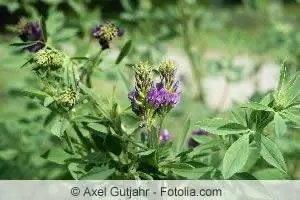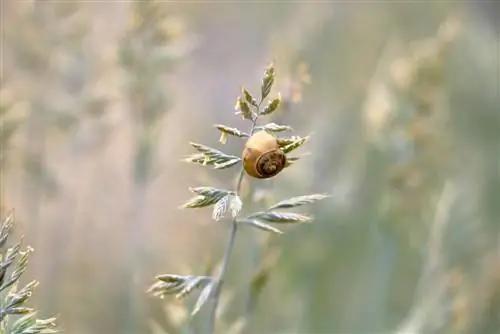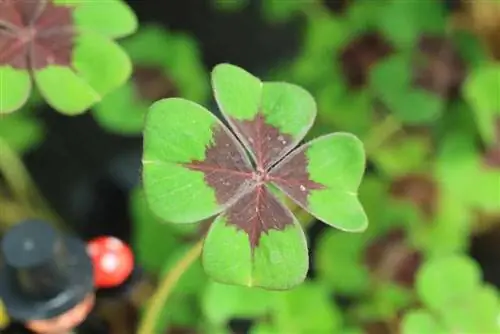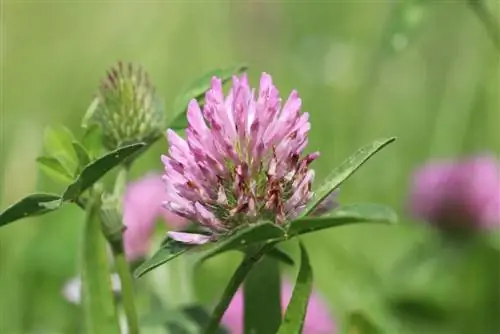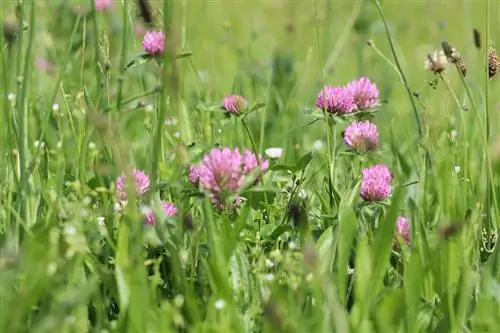- Author admin [email protected].
- Public 2023-12-17 03:39.
- Last modified 2025-01-24 12:45.
Snail clover, better known as alfalfa, is a fairly undemanding plant. Because it improves soil quality and attracts bees and bumblebees, it is an asset to the garden. It fits particularly well in natural beds. The sprouts, leaves and flowers can also be used in many different ways in the kitchen. It doesn't take much for a successful culture, but the conditions still have to be right. You should pay attention to proper care, especially at the beginning, as this will reduce the effort later.
Location
The alfalfa needs a sunny location that can warm up quickly and is dry. North sides, shaded areas and cold, damp corners are therefore extremely unfavorable.
Tip:
Beds that have not been fallow for too long before sowing are also well suited.
Substrate
Dry, loose soils are preferred by snail clover. However, it can also thrive in heavy soil if it is not prone to compaction and is deep. Normal garden soil is completely sufficient for him. If it is very solid, adding sand to loosen it up may make sense. As does mixing in compost. A pH value between 6 and 7.5 is also ideal.
Preparation
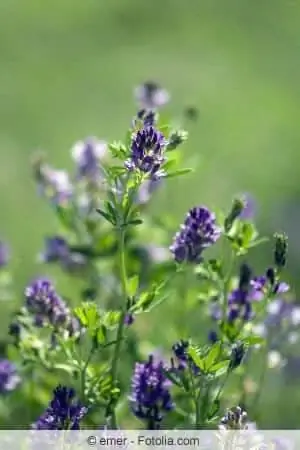
In order for alfalfa to quickly gain a foothold and thrive for years to come, it needs plenty of downward space. Their roots can reach several meters into the ground, ensuring that the plant can support itself even in dry phases. It therefore makes sense to dig deeply and loosen up the planned location. As does enriching the soil with compost or manure.
Tip:
The more thorough this is, the lower the maintenance effort will be later. So the effort is worth it in the long run.
Sowing
Hobby gardeners can take plenty of time to sow alfalfa. It is possible from March to August. If you want to harvest early in the first year, you should of course sow early. Apart from the unusually large time window, there are still special features when sowing snail clover. Firstly, the form of sowing. Even with large-scale cultivation, this should not be done in rows, but rather widely. This reduces weed pressure.
On the other hand, the shallow sowing depth. The seeds should not be deeper than one centimeter below the surface. If the substrate cover is higher, germination problems quickly arise for the otherwise fast-growing plant. However, this also makes them more susceptible to being eaten by birds and wild animals. Covering the sowing area is therefore recommended during the initial period. After sowing, the bed should be watered well but not washed.
Pouring
Watering alfalfa is usually only possible during the first shoots. Once the plants have reached a height of 80 cm to 100 cm, the roots are usually many times longer. The plants can then supply themselves with water and survive dry periods. Additional watering is only necessary if the snail clover shows signs of deficiency and the leaves become limp or collapse during the day.
Fertilize
Another special feature of alfalfa is its ability to independently produce nitrogen and store it in root nodules.
If the soil was enriched with compost before sowing, it can do without further nitrogen fertilization because it supplies itself with this as well as water. However, it can benefit from magnesium, potassium and phosphorus. It is therefore beneficial to use a nitrogen-free agent, such as GreenGrass lawn fertilizer. However, this should not be done too quickly. If the snail clover thrives without additional nutrients, it is of course not necessary.
Blend
The alfalfa can be radically cut or harvested up to four times a year. There is no need to wait for a specific point in time. However, there is one point to note. If alfalfa is to be cultivated as a perennial plant, it must be allowed to flower at least once a year.
Usage
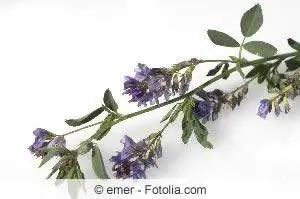
Although alfalfa is primarily known as a nutrient-rich livestock feed, it has long since found its way into he althy nutrition under a different name. Traded as alfalfa, the sprouts can be eaten raw or dried. But other parts of alfalfa are also suitable for consumption. The young leaves can be enjoyed raw in soup, sauce and salad. The flowers are suitable for teas.
Wintering
Alfalfa is hardy and does not need protection against frost.
Typical diseases, care errors and pests
Alfalfa is fast-growing, but quite susceptible to some diseases and pests. The most dangerous threats are downy mildew and leaf edge beetles, or their larvae. Downy mildew manifests itself as whitish to yellowish spots on the leaves. In order to combat it effectively and quickly, it is usually sufficient to radically cut the alfalfa. The cut plant parts must be destroyed, as the pathogens would only spread further on the compost.
The leaf edge beetle is more difficult to detect and control. The adult pests feed on the leaves of the alfalfa, but usually don't cause too much damage. However, the larvae of the beetle, which it deposits after eating the leaves, are dangerous. These are found in the soil and feed on the nitrogen depots of the plants. This can only be seen when the roots are dug up, apart from the diminishing vigor. Here the nodules appear hollowed out at the roots. If the alfalfa is growing poorly, some plants should be dug up to check. It is best to control the beetles while they are still eating the leaves. If there are few plants, collecting them is cheap. For larger areas, insecticides must be used.
Frequently asked questions
Why do alfalfa leaves fold up?
If the leaves of the snail clover close overnight, there is no need to worry. The plant uses this mechanism to reduce evaporation. If the leaves close during the day, this is due to a lack of water in the soil. Watering solves the problem.
Does crop rotation have to be observed with alfalfa?
No, snail clover is self-compatible and can easily grow in the same location for several years. Other plants in the pre-culture do not affect growth either. By the way, beds where alfalfa has grown are well supplied with nitrogen and are therefore also ideal for heavy eaters.
What you should know about alfalfa in brief
- Alfalfa has been used as a fodder plant for livestock for many centuries.
- It originally comes from Persia, where it was mainly used to feed horses.
- It came to Germany via Italy around 1700 and has been successfully grown here since then as a plant for fodder and hay.
- It is also known as the “queen of forage plants”.
Cultivation
- Seeds for alfalfa can be sown from the beginning of April to the end of July.
- Alfalfa is not very demanding when it comes to soil conditions and thrives even on rather difficult soils. However, for a good harvest, loose soil is required so that waterlogging does not form. This plant is not so well suited to very heavy or dense soils.
- The alfalfa also doesn't place great demands on water supply and grows quite well even with little rainfall, provided it has had the opportunity to form sufficient roots beforehand.
- The plant itself grows up to one meter high, but forms root systems to a depth of five meters.
- However, it grows best in a warm and dry climate with lots of sunshine.
- Alfalfa is perennial, hardy and can easily survive frosts.
- It is also well suited for green manure because it absorbs nitrogen from the air with the help of bacteria and binds it.
Fodder and hay from alfalfa
The alfalfa can be mown several times a year and then dried to use as hay. It is particularly fed to dairy cows, horses, sheep and small livestock and contains a lot of protein as well as some vitamins and nutrients. Lucerne is sold in the form of bales or pellets.
- In Germany, alfalfa is usually only grown on an area for two to three years because after that the yields decrease.
- However, only bastard alfalfa is sown here, which is a cross between seed alfalfa and sickle alfalfa.
- Although seed alfalfa is very productive, it is hardly hardy, whereas sickle alfalfa is very robust.
- There are different varieties of bastard alfalfa, each bred for specific locations.

